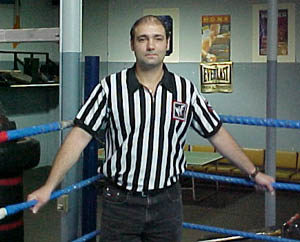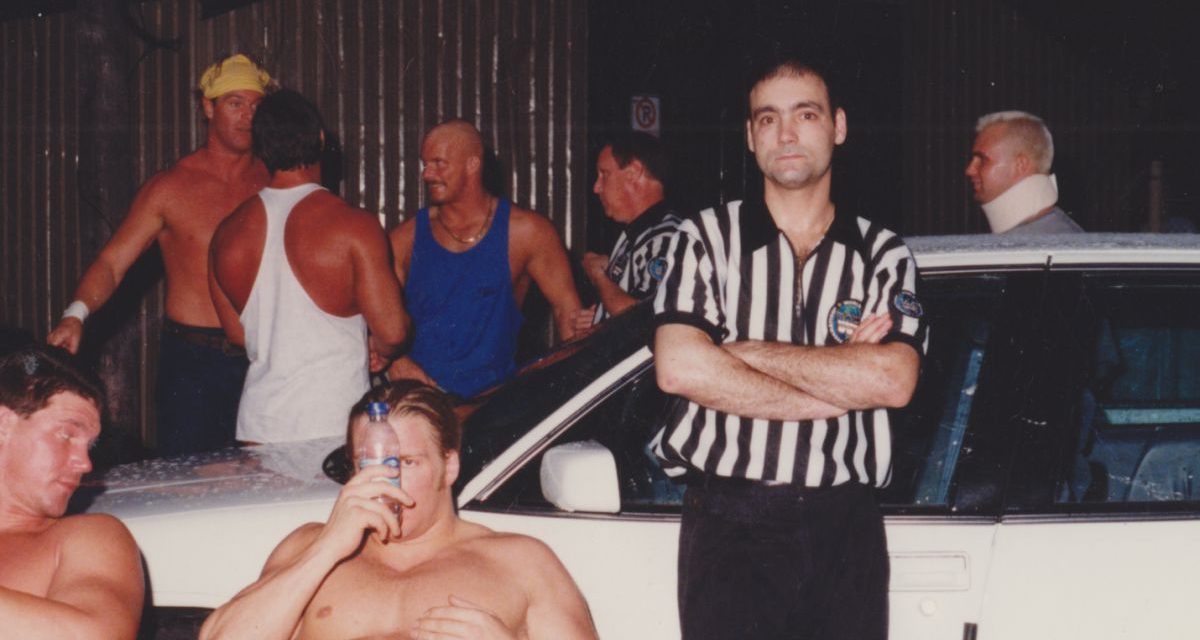REAL NAME: Jim Korderas
5’11” (“debatable”), “fluctuating between 190 and 200, depends on how well my wife cooks that day”
BORN: March 19, 1962 in East York (Toronto), Ontario
The WWF personality with the most history in Toronto isn’t Edge, Christian, Test, Trish Stratus or Val Venis — all of whom are from the area — it’s the person that you’re not supposed to pay attention to until he misses something:
Referee Jim Korderas.

Jim Korderas poses for SLAM! Wrestling June 7, 2001. — Pejman Ramezanpour, CANOE
Korderas was born in Toronto, and was raised watching the greats of the past wrestle at Maple Leaf Gardens. His favourites were Tex McKenzie, The Original Sheik, and Abdullah the Butcher “I was always into heels for some reason, except for Tex,” he told SLAM! Wrestling.
Being a major fan, naturally he started taking photos. Pretty good photos actually. Then he started selling them outside Maple Leaf Gardens, which got the attention of promoter Jack Tunney’s right-hand man Elio Zarlenga, who put together the wrestling program.
Korderas, 39, admits that it was a “little illegal” to be selling the photos. “[Zarlenga] caught me and was actually impressed with the quality of pictures I was taking. We kind of became buddy-buddies,” Korderas explained. “He introduced me to Jack, and I guess Jack said, ‘We don’t need another photographer, but we’ll keep him around and use him for something.’ I started off setting up the ring, that sort of stuff. About a year and a half later, they asked me if I wanted to start refereeing. I said, sure, I’ll try it.”
Well-known Toronto names Billy Red Lyons, Terry Yorkston, and John Bonello showed him the ropes.
He worked locally for the Toronto office of the WWF, continuing to hold other jobs in town, including working at a garage and at Brewer’s Retail, the Ontario government-run beer store.
Around 1988, he was practically working full-time for the WWF, working TV tapings and house shows.
He says that the WWF in Stamford, CT has always been there for him. “The hard part is getting your foot in the door. That’s the hard part. Once you get your foot in the door, as long as you work hard and show them that you’re willing to work hard, they’re very loyal that way.”
In the late ’80s, early ’90s, he took time off. A few years later, he called up and got his gig back and has been touring the continent ever since.
Yet, he says that he’s not in wrestling for fame — he does it for love of the sport. “I’m not out there to be a star or anything, I just love what I’m doing,” Korderas said. “I’d rather be more anonymous … I’ll tell you what, the kids seem to recognize the refs more than anybody. They see everything, they pay attention to everything. They’re the ones who mostly spot us out when we’re dressed like civilians.” Fans who have met Korderas know that he always makes time to talk and sign autographs, even though he might have a tight schedule or be jet-lagged.
On the homefront, it’s a mixed bag. “It’s a little rough on the wife, but she knew what she was getting into when we first got married. But she’s really supportive. My dad loves it. He’s marking out over the fact that I’m on TV. My mom thinks I’m going to get killed one day. That’s my mother, especially a Greek mother. But everybody else is real cool about it.” In fact, every time the WWF comes to Toronto, he has friends calling him up for tickets. “They always hit you up for tickets, but you can’t get everybody tickets!” he lamented.
He has no hesitation when asked about his mentors. “The Hebners, David and Earl, they’re the guys that really don’t feel threatened by anybody coming up. They’re really willing to help everybody.” The wrestlers, too, are very helpful.
Korderas likes to be involved with the wrestlers when the match for that evening is being planned. “When they’re going over a match, for example, I like to be there to listen to the the whole thing instead of just things that I need to know. I like to listen to the whole match,” he said. Sometimes, he contributes an idea. “I don’t like to butt in on their match, because it is their match. But if I think I have what I think is a good idea, I’ll mention it. They’ve liked it a couple of times.”
The wrestlers themselves, he says, aren’t better or worse, just “different” to work with. “Everybody’s got a different kind of a style, and everybody has a different approach to matches, which makes it good. That’s what makes more variety of matches, more variety of styles. So I wouldn’t so there’s anybody really better to work with. Sometimes there’s guys you get used to working with if you’ve worked with them a lot. Then there’s others that you don’t get to work with a lot so they don’t know the referee, for example. Every referee, nobody counts the same. You have to get used to the referee also.”
Being a referee now is more challenging than when he started. “Especially with the guys taking the business to a whole new level, you have to pay attention a lot more, a lot of the spots that they do are a lot more intricate. I’m trying to be more creative in there too. It’s not the old stand-around-and-wait-until-somebody’s-pinned, count-three.”
When he was first into the business, Korderas used to go to the gym as well as referee. Now, he figures that the exercise he gets on the road is enough. “Now I think the actual setting up part of the event, setting up the ring and that sort of stuff, I think that’s enough exercise, at this point in my life anyways,” he said with a laugh.
Plus there’s the runs to the ring to break up the bruhahas. “That’s our cardiovascular, that’s our running — running down the ramp, jumping in the ring and breaking stuff up!”
Running to the ring during the TV tapings can be harrowing. “Seven [refs] have to run down and break up this schmozz that’s going on. A couple of times, coming down that ramp, you gain up some momentum going down that ramp, and sometimes you’ve got the cameramen down at ringside, you’re trying to dodge cameramen. I remember one time, Mike Chioda was running to the ring, and he got cutoff by a cameraman, so he had to stop and we were all coming in behind him, and almost all squooshed him on the side of the ring trying to get in there.”
On the TV tapings, Korderas is fitted with a clear earpiece, custom fit to the individual ear. “The first ones we had were horrible. They were that little nub that pushes in and kind of hurt. Now they’re moulded to our ears.”
The tapings themselves can be tense. “It’s live TV and you do have to hit the times exact. House shows are a little more relaxed, a little more laid back, especially in the matches because the guys have more time to tell a story.”
Of course, sometimes the story being told requires him to miss an infraction — or three. It’s a skill, but to Korderas, it’s only a “tiny thing.”
“You’ve got to get used to the people in the ring,” he said. “You’ve also got to listen because as this is going on, everyone is sort of communicating with each other. Just pay attention, listen to the guys — they’ll let you know.”
The name of the great NWA ref Tommy Young comes up. “Tommy was very animated in the ring, which is one of the things that make him stand out.” Korderas compares Young to Earl Hebner, senior WWF ref. “Earl’s style isn’t as animated as Tommy’s, but Earl is always there. He’s one of those guys that knows to be in the right position at the right time. My thing is that I try not to be too animated, but also look interested. The referee should be a part of the match, but not the focal point part of the match. The match itself should be the focal point.”
So next time you’re watching a match, try to watch the ref. Chances are that just like the wrestlers in the ring, the referee is also living a lifelong dream of being in the WWF.
It sure stands true for Korderas, who promises to be there for the WWF “as long as they want me.”
JIM KORDERAS STORIES
- Apr. 21, 2024: Ref Korderas on old friends and properly taking a bump
- Aug. 16, 2013: Ex-WWE ref Korderas makes his wrestling debut
- Mar. 29, 2013: One, two, three! WWE ref Korderas’ book hits shelves
- Mar. 26, 2010: Korderas offers advice on reffing, Mania
Memories
The best memory has to be during the scab angle when Jim went against the other refs. He became head ref of the WWF according to the gimmick, which all led to the PPV when he got beat down by the other refs. Very funny stuff. Even funnier is on Raw when he has a cast on his arm cause the refs broke his arm. The funniest part of all this is the next time we saw him on TV after Raw was that he was 100% fine, no bumps or bruises at all.
Adam L.
My memories of Jim Korderas essentially began as a child saving my allowances so my friend Dave & I could buy pictures from him for our wrestling album. We would always look for him on Wood Street and race to see him and his pictures.
Not only is Jim a great referee, he took the best pictures ever, I have tonnes of them to this day. We got to know Jim later on as a friend and to say this guy is top drawer would be an understatement. No matter what he always knew your name and came over to shake your hand. I remember all the get togethers we had at the old Howard Johnson’s & Venture Inn with Jim and all the boys
Great guy, great referee, represents Canada and Toronto oh so well.
Terry Harris

